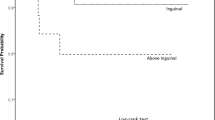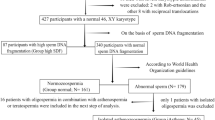Abstract
Subfertility is a risk factor for testicular cancers (TT), and conversely, TT may induce subfertility due to local and regional toxic effects. We aimed to identify the association between TT characteristics and pre-orchidectomy azoospermia. A systematic review of the literature was performed according to the PRISMA checklist. Overall, eight non-randomised studies involving 469 men with TT (azoospermia, n = 57; no azoospermia n = 412) were included in the qualitative analysis. Bilateral TT (12.3% vs 2.9% in non-azoospermia), non-seminoma germ cell tumours (6.4% vs 1.9%), germ cell neoplasia in-situ (GCNIS) (11.1% vs 1.2%), stage 2–3 disease (22.2% vs 0%), Sertoli Cell only (SCO) on biopsy (60% vs 37.5%) and a history of undescended testis (UDT) (66.7% vs 50%) were more common in azoospermic men. FSH levels are higher (18.7–23.2 mIU/L vs <0.1–8 mIU/L in non-azoospermia), testosterone is lower, and testis size are smaller (lower range 1 mL vs 10 mL) in men with azoospermia. Leydig cell tumours and hyperplasia were only detected in men with azoospermia. In summary, bilateral TT, GCNIS, higher tumour stage, smaller testes, SCO and history of UDT may have direct effects on spermatogenesis. Small testis, raised FSH and low testosterone may reflect reduced testicular function in azoospermic men. Performing a pre-orchidectomy semen analysis is important to identify those with azoospermia or severe oligospermia in order to plan for cryopreservation or onco-TESE in young men who wish to conceive.
This is a preview of subscription content, access via your institution
Access options
Subscribe to this journal
Receive 8 print issues and online access
$259.00 per year
only $32.38 per issue
Buy this article
- Purchase on Springer Link
- Instant access to full article PDF
Prices may be subject to local taxes which are calculated during checkout

Similar content being viewed by others
References
Ferlay J, Colombet M, Soerjomataram I, Parkin DM, Piñeros M, Znaor A, et al. Cancer statistics for the year 2020: An overview. Int J cancer. 2021 Apr.
Gillessen S, Sauvé N, Collette L, Daugaard G, de Wit R, Albany C, et al. Predicting Outcomes in Men With Metastatic Nonseminomatous Germ Cell Tumors (NSGCT): Results From the IGCCCG Update Consortium. J Clin Oncol. 2021;39(May):1563–74.
Laguna M, Albers P, Algaba F, Bokemeyer C, Boormans J, Fischer S, et al. Testicular Cancer [Internet]. EAU Guidel. 2021. Available from: https://uroweb.org/guideline/testicular-cancer.
Petersen P, Skakkebaek N, Rørth M, Giwercman A. Semen quality and reproductive hormones before and after orchiectomy in men with testicular cancer. J Urol. 1999;161:822–6.
Rives N, Perdrix A, Hennebicq S, Saïas-Magnan J, Melin M-C, Berthaut I, et al. The semen quality of 1158 men with testicular cancer at the time of cryopreservation: results of the French National CECOS Network. J Androl. 2012;33:1394–401.
Moody JA, Ahmed K, Horsfield C, Pedersen MRV, Yap T, Shabbir M. Fertility preservation in testicular cancer - predictors of spermatogenesis. BJU Int. 2018;122:236–42.
Corona G, Minhas S, Giwercman A, Bettocchi C, Dinkelman-Smit M, Dohle G, et al. Sperm recovery and ICSI outcomes in men with non-obstructive azoospermia: a systematic review and meta-analysis. Hum Reprod Update. 2019;25:733–57.
Skakkebaek NE, Rajpert-De Meyts E, Main KM. Testicular dysgenesis syndrome: an increasingly common developmental disorder with environmental aspects. Hum Reprod. 2001;16(May):972–8.
Hanson HA, Anderson RE, Aston KI, Carrell DT, Smith KR, Hotaling JM. Subfertility increases risk of testicular cancer: evidence from population-based semen samples. Fertil Steril. 2016;105(Feb):322–8. e1
Jacobsen R, Bostofte E, Engholm G, Hansen J, Olsen JH, Skakkebaek NE, et al. Risk of testicular cancer in men with abnormal semen characteristics: cohort study. BMJ 2000;321(Sep):789–92.
Peng X, Zeng X, Peng S, Deng D, Zhang J. The association risk of male subfertility and testicular cancer: a systematic review. PLoS One. 2009;4:e5591.
Ostrowski KA, Walsh TJ. Infertility with Testicular Cancer. Urol Clin North Am. 2015;42(Aug):409–20.
Page MJ, McKenzie JE, Bossuyt PM, Boutron I, Hoffmann TC, Mulrow CD, et al. The PRISMA 2020 statement: an updated guideline for reporting systematic reviews. BMJ. 2021;372:n71.
Johnsen SG. Testicular biopsy score count-a method for registration of spermatogenesis in human testes: normal values and results in 335 hypogonadal males. Hormones 1970;1:2–25.
Peinemann F, Kleijnen J. Development of an algorithm to provide awareness in choosing study designs for inclusion in systematic reviews of healthcare interventions: a method study. BMJ Open. 2015;5(Aug):e007540.
Wells G, Shea B, O’Connell D, Peterson J, Welch V, Losos M, et al. The Newcastle-Ottawa Scale (NOS) for assessing the quality of nonrandomised studies in meta-analyses [Internet]. 2012. Available from: http://www.ohri.ca/programs/clinical_epidemiology/oxford.asp.
Hessel M-L, Ramos L, D’Hauwers KWM, Braat DDM, Hulsbergen-van de Kaa CA. Beneficial value of testicular sperm extraction-AgarCyto in addition to the standard testicular biopsy for diagnosis of testicular germ cell tumors in nonobstructive azoospermia. Fertil Steril. 2016;105(Feb):308–14. e1.
Furuhashi K, Ishikawa T, Hashimoto H, Yamada S, Ogata S, Mizusawa Y, et al. Onco-testicular sperm extraction: testicular sperm extraction in azoospermic and very severely oligozoospermic cancer patients. Andrologia 2013;45(Apr):107–10.
Bizet P, Saias-Magnan J, Jouve E, Grillo JM, Karsenty G, Metzler-Guillemain C, et al. Sperm cryopreservation before cancer treatment: a 15-year monocentric experience. Reprod Biomed Online. 2012;24(Mar):321–30.
Mancini M, Carmignani L, Gazzano G, Sagone P, Gadda F, Bosari S, et al. High prevalence of testicular cancer in azoospermic men without spermatogenesis. Hum Reprod. 2007;22(Apr):1042–6.
Tomita E, Kondo T, Nakazawa H, Ito F, Hashimoto Y, Tanabe K. Successful testis preservation for bilateral testicular tumors with a new chemotherapy-based protocol: initial results of three cases. Int J Urol. 2007;14(Sep):879–82.
Skakkebaek NE, Holm M, Hoei-Hansen C, Jørgensen N, Rajpert-De Meyts E. Association between testicular dysgenesis syndrome (TDS) and testicular neoplasia: evidence from 20 adult patients with signs of maldevelopment of the testis. APMIS. 2003;111(Jan):1–9. discussion 9-11.
Baniel J, Sella A. Sperm extraction at orchiectomy for testis cancer. Fertil Steril. 2001;75(Feb):260–2.
Kliesch S, Bergmann M, Hertle L, Nieschlag E, Behre HM. Semen parameters and testicular pathology in men with testicular cancer and contralateral carcinoma in situ or bilateral testicular malignancies. Hum Reprod. 1997;12(Dec):2830–5.
Botchan A, Hauser R, Yogev L, Gamzu R, Paz G, Lessing JB, et al. Testicular cancer and spermatogenesis. Hum Reprod. 1997;12(Apr):755–8.
Agarwal A, Tolentino MV, Sidhu MDRS, Ayzman I, Lee J-C, Thomas AJ, et al. Effect of cryopreservation on semen quality in patients with testicular cancer. Urology 1995;46(Sep):382–9.
Cioppi F, Rosta V, Krausz C Genetics of Azoospermia. Int J Mol Sci. 2021 Mar;22.
Author information
Authors and Affiliations
Contributions
KHP had full access to all the data in the study and takes responsibility for the integrity of the data and the accuracy of the data analysis. Study concept and design: HA. Acquisition of data: KHP, NIO. Analysis and interpretation: KHP, NIO, AM, HA. Drafting of the manuscript: KHP. Critical revision of the manuscript: KHP, NIO, AM, HA. Statistical analysis: KHP. Obtaining funding: None. Administrative, technical or material support: None. Supervision: HA.
Corresponding author
Ethics declarations
Competing interests
KHP certifies that all conflicts of interest, including specific financial interests and relationships and affiliations relevant to the subject matter or materials discussed in the manuscript (e.g. employment/affiliation, grants or funding, consultancies, honoraria, stock ownership or options, expert testimony, royalties, or patents filed, received, or pending), are the following: None.
Additional information
Publisher’s note Springer Nature remains neutral with regard to jurisdictional claims in published maps and institutional affiliations.
Supplementary information
Rights and permissions
About this article
Cite this article
Pang, K.H., Osman, N.I., Muneer, A. et al. The relationship between testicular tumour characteristics and azoospermia: a systematic review. Int J Impot Res 34, 543–551 (2022). https://doi.org/10.1038/s41443-021-00492-x
Received:
Revised:
Accepted:
Published:
Issue Date:
DOI: https://doi.org/10.1038/s41443-021-00492-x
This article is cited by
-
Subsets of preoperative sex hormones in testicular germ cell cancer: a retrospective multicenter study
Scientific Reports (2023)



